Seat Exeo ST 2013 Owner's manual
Manufacturer: SEAT, Model Year: 2013, Model line: Exeo ST, Model: Seat Exeo ST 2013Pages: 327, PDF Size: 5.07 MB
Page 271 of 327

269
If and when
The sealing compound must not be used in the following cases:
β If the cuts and punctures on the tyre are longer than 4 mm ββFig. 201 1
β
If the wheel rim has been damaged 2β
If you have been driving with very low pressure or a completely flat tyre
3
How to use the TMS (tyre mobility system) is described in the section Re-
pairing a tyre ββpage 270 and in the instructions supplied with the tyre
sealant can.
The TMS (tire mobility system) can be used at outside temperatures down
to -20 Β°C.
WARNING
After repairing a tyre please note the following points:
β Do not drive faster than 80 km/h (50 mph).
β Avoid heavy acceleration, hard braking and fast cornering.
β Vehicle handling could be impaired.
β Tyres which have been sealed using the Tyre Mobility System are only
suitable for temporary use over a short period.
β After using the tyre sealant the tyre pressure monitoring system* may
malfunction. Therefore, please drive carefully to the next available speci-
alised workshop.
β The Tyre Mobility System must NOT be used:
β If the cuts and punctures on the tyre are longer or wider than
4 mm.
β if the wheel rim has been damaged.
β If you have been driving with very low pressure or a completely flat
tyre.
β Seek professional assistance if the repair of a tyre puncture is not
possible with the sealing product.
WARNING (Continued)
β Do not allow the sealing product to come into contact with your eyes,
skin or clothing.
β If you do come into contact with the sealing product immediately
rinse the eyes or skin affected with clean water.
β Change clothing immediately if it becomes soiled with the sealing
product.
β Make sure you do not breathe in the fumes!
β If any of the sealing product is accidentally ingested, immediately
rinse the mouth thoroughly and drink lots of water.
βDo not induce vomiting. Seek medical assistance if needed.
β If any allergic reactions should occur get medical help immediately.
β Keep the sealing product away from children.
For the sake of the environment
If you have to dispose of a sealant can, go to a specialised waste service or
to a SEAT Technical Service, where the product can be recycled in an appro-
priate waste container.
Note
β If sealing product should leak out, leave it to dry. This way you can pull it
off like a piece of foil.
β Observe the expiry date stated on the sealing compound can. Have the
sealing compound exchanged by a specialised workshop. ο
Safety FirstOperating instructionsPractical TipsTechnical Specifications
Page 272 of 327
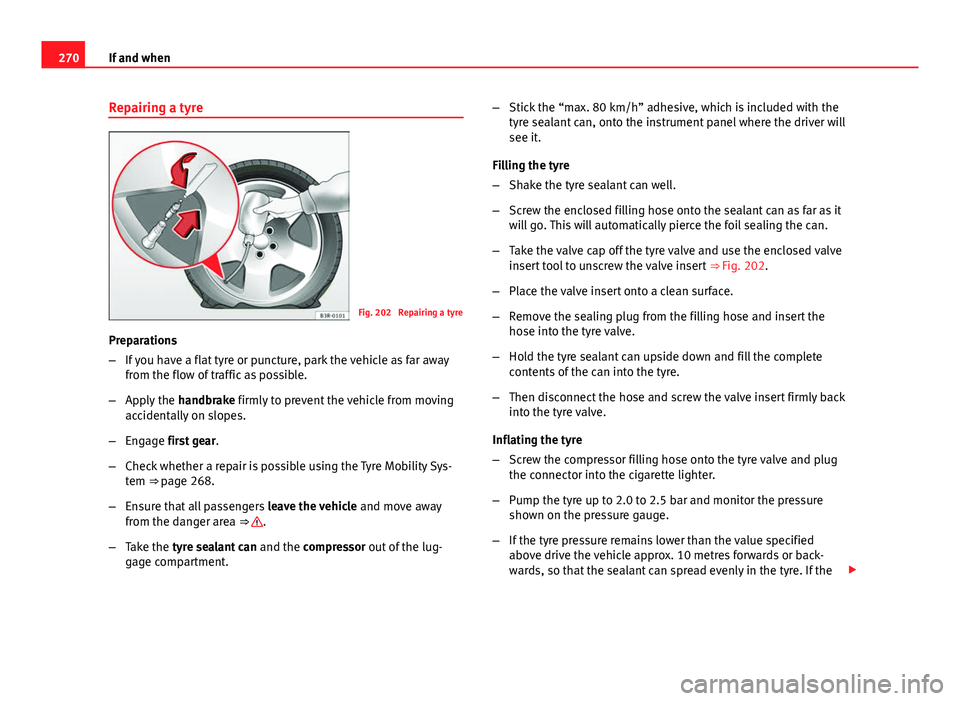
270If and when
Repairing a tyre
Fig. 202 Repairing a tyre
Preparations
β If you have a flat tyre or puncture, park the vehicle as far away
from the flow of traffic as possible.
β Apply the handbrake firmly to prevent the vehicle from moving
accidentally on slopes.
β Engage first gear .
β Check whether a repair is possible using the Tyre Mobility Sys-
tem ββpage 268.
β Ensure that all passengers leave the vehicle and move away
from the danger area ββ
.
β Take the tyre sealant can and the compressor out of the lug-
gage compartment. β
Stick the βmax. 80 km/hβ adhesive, which is included with the
tyre sealant can, onto the instrument panel where the driver will
see it.
Filling the tyre
β Shake the tyre sealant can well.
β Screw the enclosed filling hose onto the sealant can as far as it
will go. This will automatically pierce the foil sealing the can.
β Take the valve cap off the tyre valve and use the enclosed valve
insert tool to unscrew the valve insert ββFig. 202.
β Place the valve insert onto a clean surface.
β Remove the sealing plug from the filling hose and insert the
hose into the tyre valve.
β Hold the tyre sealant can upside down and fill the complete
contents of the can into the tyre.
β Then disconnect the hose and screw the valve insert firmly back
into the tyre valve.
Inflating the tyre
β Screw the compressor filling hose onto the tyre valve and plug
the connector into the cigarette lighter.
β Pump the tyre up to 2.0 to 2.5 bar and monitor the pressure
shown on the pressure gauge.
β If the tyre pressure remains lower than the value specified
above drive the vehicle approx. 10 metres forwards or back-
wards, so that the sealant can spread evenly in the tyre. If the ο£
Page 273 of 327

271
If and when
pressure is still lower than the specification the tyre is too badly
damaged and cannot be repaired using the tyre sealant.
Final check
β After about 10 minutes, stop to check the tyre pressure.
β If tyre pressure is less than 1.3 bar, the tyre is too badly dam-
aged. Do not drive on! You should obtain professional assis-
tance.
WARNING
β If you have a puncture in heavy traffic, switch on the hazard warning
lights and place the warning triangle in a visible location. This is for your
own safety and also warns other road users.
β Make sure your passengers wait in a safe place (for instance behind
the roadside crash barrier).
β Please observe the manufacturer's safety notes on the compressor
and the instructions supplied with the tyre sealant can.
β If it is not possible to build up a tyre pressure of 2.0 bar within 6 mi-
nutes this means that the tyre is too badly damaged. Do not drive on!
β Seek professional assistance if the repair of a tyre puncture is not
possible with the sealing product.
β If tyre pressure is less than 1.3 bar after driving about 10 minutes,
the tyre is too badly damaged. Do not drive on! Obtain technical assis-
tance.
CAUTION
Take special care if you have to repair a tyre on a slope.
Note
β Do not use the compressor for longer than 6 minutes. Otherwise, it
might overheat. When the compressor has cooled down, you can use it
again.
β If tyre sealant should leak out, leave it to dry and then pull it off like foil.
β After carrying out a tyre repair remember to buy a new tyre sealant can at
a specialised workshop. This will ensure that the Tyre Mobility System is op-
erative again.
β Please observe legal requirements when doing so. ο
Safety FirstOperating instructionsPractical TipsTechnical Specifications
Page 274 of 327
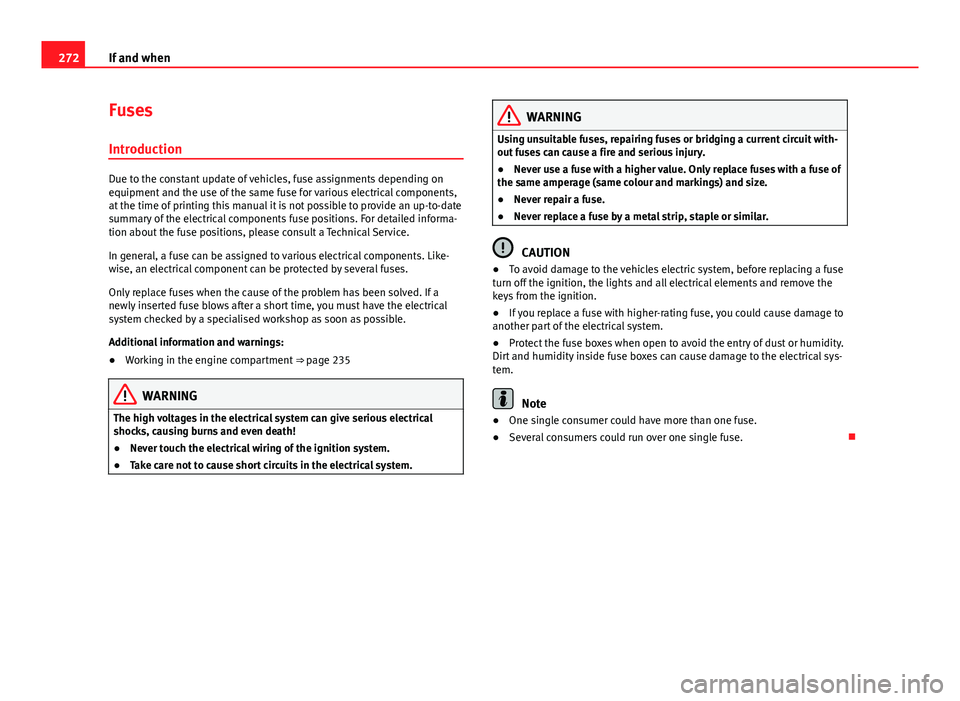
272If and when
Fuses
Introduction
Due to the constant update of vehicles, fuse assignments depending on
equipment and the use of the same fuse for various electrical components,
at the time of printing this manual it is not possible to provide an up-to-date
summary of the electrical components fuse positions. For detailed informa-
tion about the fuse positions, please consult a Technical Service.
In general, a fuse can be assigned to various electrical components. Like-
wise, an electrical component can be protected by several fuses.
Only replace fuses when the cause of the problem has been solved. If a
newly inserted fuse blows after a short time, you must have the electrical
system checked by a specialised workshop as soon as possible.
Additional information and warnings:
β Working in the engine compartment ββpage 235
WARNING
The high voltages in the electrical system can give serious electrical
shocks, causing burns and even death!
β Never touch the electrical wiring of the ignition system.
β Take care not to cause short circuits in the electrical system.
WARNING
Using unsuitable fuses, repairing fuses or bridging a current circuit with-
out fuses can cause a fire and serious injury.
β Never use a fuse with a higher value. Only replace fuses with a fuse of
the same amperage (same colour and markings) and size.
β Never repair a fuse.
β Never replace a fuse by a metal strip, staple or similar.
CAUTION
β To avoid damage to the vehicles electric system, before replacing a fuse
turn off the ignition, the lights and all electrical elements and remove the
keys from the ignition.
β If you replace a fuse with higher-rating fuse, you could cause damage to
another part of the electrical system.
β Protect the fuse boxes when open to avoid the entry of dust or humidity.
Dirt and humidity inside fuse boxes can cause damage to the electrical sys-
tem.
Note
β One single consumer could have more than one fuse.
β Several consumers could run over one single fuse. ο
Page 275 of 327

273
If and when
Vehicle fuses
Fig. 203 Fuse box cover
on the left side of the
dash panel.
Only replace fuses with a fuse of the same amperage (same colour and
markings) and size.
Identifying fuses situated below the driver-side dash panel by colours
ColourAmp ratingpurple3Light brown5Brown7,5Red10Blue15Yellow20White or transparent25Green30Orange40
Opening and closing the fuse box located on the left side of the dash panel
β Opening: Remove the fuse box cover using a screwdriver ββFig. 203.
β Closing: fit the fuse cover back on.
CAUTION
β Always carefully remove the fuse box covers and refit them correctly to
avoid problems with your vehicle.
β Protect the fuse boxes when open to avoid the entry of dust or humidity.
Dirt and humidity inside fuse boxes can cause damage to the electrical sys-
tem.
Note
In the vehicle, there are more fuses than those indicated in this chapter.
These should only be changed by a specialised workshop. ο
Replacing a blown fuse
Fig. 204 Image of a
blown fuse ο£
Safety FirstOperating instructionsPractical TipsTechnical Specifications
Page 276 of 327
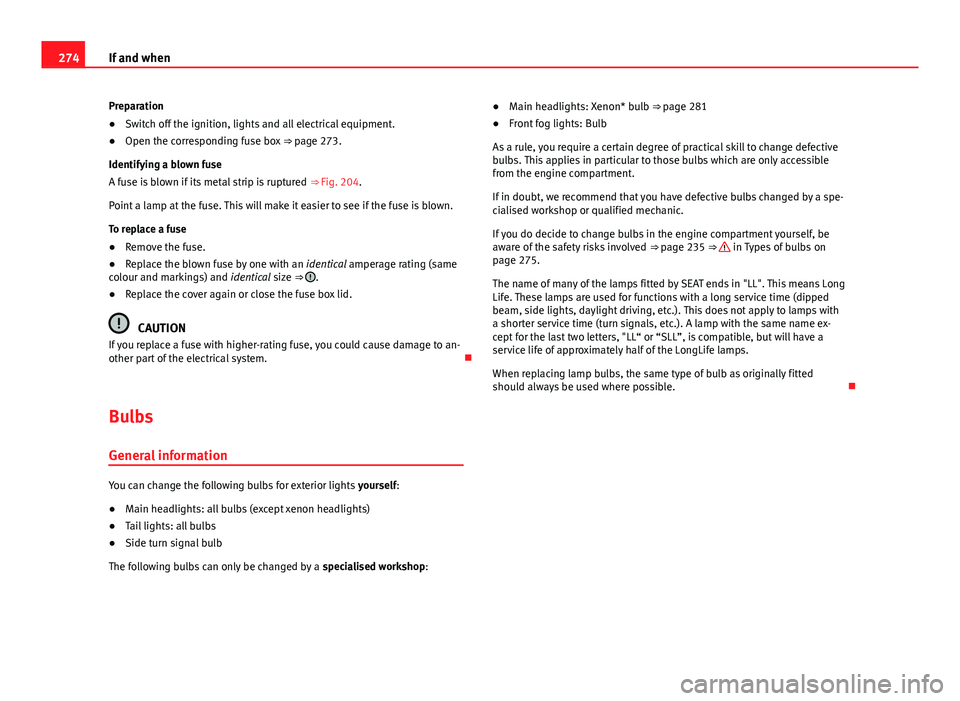
274If and when
Preparation
β Switch off the ignition, lights and all electrical equipment.
β Open the corresponding fuse box ββpage 273.
Identifying a blown fuse
A fuse is blown if its metal strip is ruptured ββFig. 204.
Point a lamp at the fuse. This will make it easier to see if the fuse is blown.
To replace a fuse
β Remove the fuse.
β Replace the blown fuse by one with an identical amperage rating (same
colour and markings) and identical size ββ
.
β Replace the cover again or close the fuse box lid.
CAUTION
If you replace a fuse with higher-rating fuse, you could cause damage to an-
other part of the electrical system. ο
Bulbs
General information
You can change the following bulbs for exterior lights yourself:
β Main headlights: all bulbs (except xenon headlights)
β Tail lights: all bulbs
β Side turn signal bulb
The following bulbs can only be changed by a specialised workshop:β
Main headlights: Xenon* bulb ββpage 281
β Front fog lights: Bulb
As a rule, you require a certain degree of practical skill to change defective
bulbs. This applies in particular to those bulbs which are only accessible
from the engine compartment.
If in doubt, we recommend that you have defective bulbs changed by a spe-
cialised workshop or qualified mechanic.
If you do decide to change bulbs in the engine compartment yourself, be
aware of the safety risks involved ββpage 235 ββ
in Types of bulbs on
page 275.
The name of many of the lamps fitted by SEAT ends in "LL". This means Long
Life. These lamps are used for functions with a long service time (dipped
beam, side lights, daylight driving, etc.). This does not apply to lamps with
a shorter service time (turn signals, etc.). A lamp with the same name ex-
cept for the last two letters, "LLβ or βSLLβ, is compatible, but will have a
service life of approximately half of the LongLife lamps.
When replacing lamp bulbs, the same type of bulb as originally fitted
should always be used where possible. ο
Page 277 of 327

275
If and when
Changing bulbs. Halogen headlights Types of bulbs
You must only replace a bulb with a bulb of the same type. The name can be
found on the base of the bulb holder.
BulbTypeDipped beam headlights (halogen)12 V/55 W (H7 LL)Main beam headlights12 V/55 W (H1)Turn signal12 V/21 W (PY21W)Side lights12 V/5 W (W5W LL)
WARNING
β Take particular care when working on components in the engine com-
partment if the engine is warm. Risk of burns.
β Bulbs are highly sensitive to pressure. The glass can break when you
touch the bulb, causing injury.
β The high voltage element of gas discharge bulbs* (xenon light) must
be handled correctly. Otherwise, there is a risk of death.
β When changing bulbs, please take care not to injure yourself on sharp
parts in the headlight housing.
CAUTION
β Remove the ignition key before working on the electric system. Other-
wise, a short circuit could occur.
β Switch off the lights or parking lights before you change a bulb.
For the sake of the environment
Please ask your specialist retailer how to dispose of used bulbs in the prop-
er manner.
Note
β Depending on weather conditions (cold or wet), the front lights, the fog
lights, the tail lights and the turn signals may be temporarily misted. This
has no influence on the useful life of the lighting system. By switching on
the lights, the area through which the beam of light is projected will quickly
be demisted. However, the edges may continue to be misted.
β Please check at regular intervals that all lighting (especially the exterior
lighting) on your vehicle is functioning properly. This is not only in the inter-
est of your own safety, but also in that of all other road users.
β Before changing a bulb, make sure you have the correct new bulb.
β Do not touch the glass part of the bulb with your bare hands, use a cloth
or paper towel instead. Otherwise, the fingerprints left on the glass will va-
porise as a result of the heat generated by the bulb, they will be deposited
on the reflector and will impair its surface. ο
Safety FirstOperating instructionsPractical TipsTechnical Specifications
Page 278 of 327
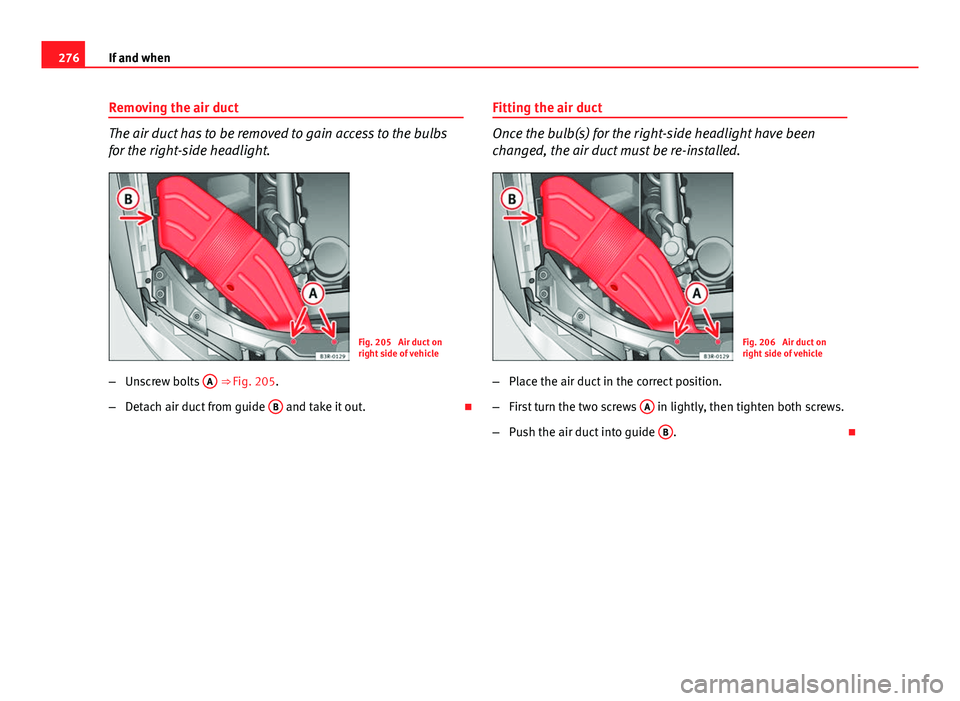
276If and when
Removing the air duct
The air duct has to be removed to gain access to the bulbs
for the right-side headlight.
Fig. 205 Air duct on
right side of vehicle
β Unscrew bolts A
ββFig. 205.
β Detach air duct from guide B
and take it out. οFitting the air duct
Once the bulb(s) for the right-side headlight have been
changed, the air duct must be re-installed.
Fig. 206 Air duct on
right side of vehicle
β Place the air duct in the correct position.
β First turn the two screws A
in lightly, then tighten both screws.
β Push the air duct into guide B
. ο
Page 279 of 327
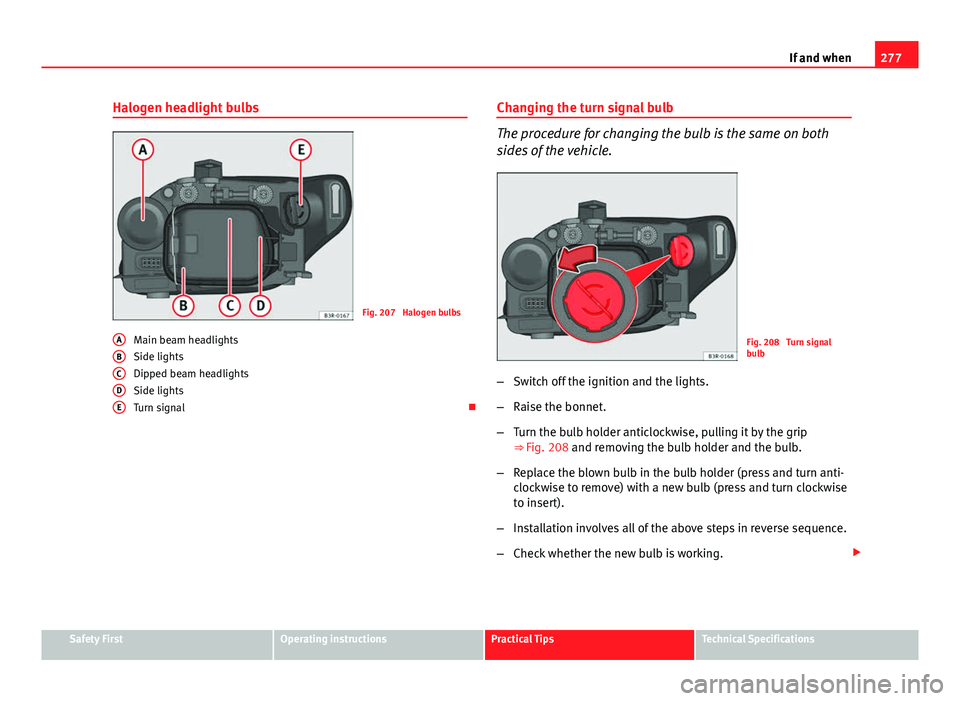
277
If and when
Halogen headlight bulbs
Fig. 207 Halogen bulbs
Main beam headlights
Side lights
Dipped beam headlights
Side lights
Turn signal ο
A
BCDE
Changing the turn signal bulb
The procedure for changing the bulb is the same on both
sides of the vehicle.
Fig. 208 Turn signal
bulb
β Switch off the ignition and the lights.
β Raise the bonnet.
β Turn the bulb holder anticlockwise, pulling it by the grip
ββFig. 208 and removing the bulb holder and the bulb.
β Replace the blown bulb in the bulb holder (press and turn anti-
clockwise to remove) with a new bulb (press and turn clockwise
to insert).
β Installation involves all of the above steps in reverse sequence.
β Check whether the new bulb is working. ο£
Safety FirstOperating instructionsPractical TipsTechnical Specifications
Page 280 of 327
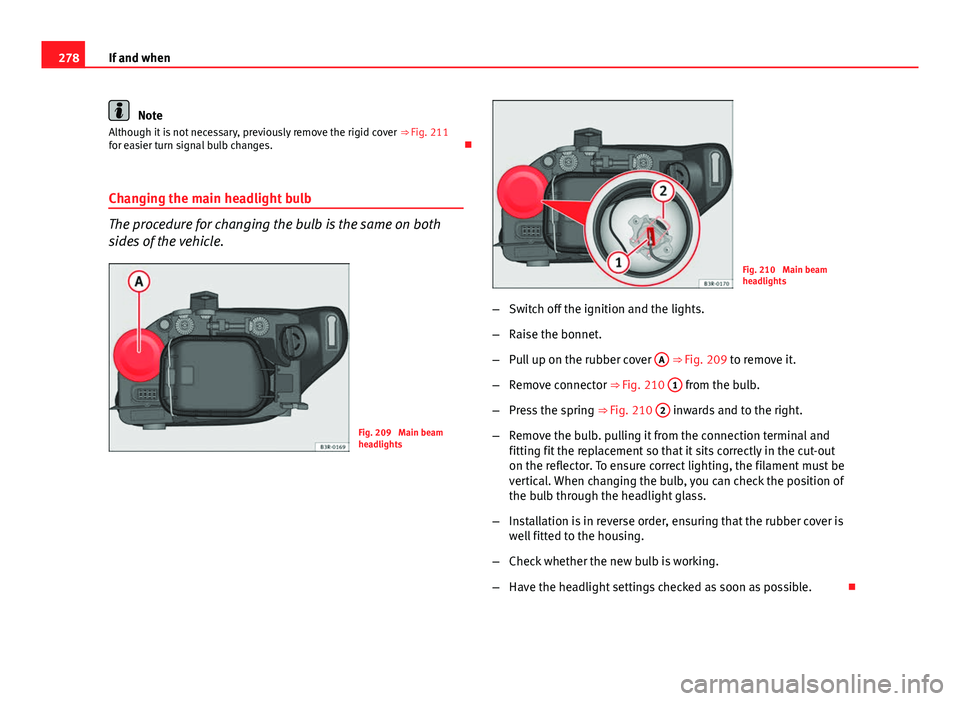
278If and when
Note
Although it is not necessary, previously remove the rigid cover ββFig. 211
for easier turn signal bulb changes. ο
Changing the main headlight bulb
The procedure for changing the bulb is the same on both
sides of the vehicle.
Fig. 209 Main beam
headlights
Fig. 210 Main beam
headlights
β Switch off the ignition and the lights.
β Raise the bonnet.
β Pull up on the rubber cover A
ββFig. 209 to remove it.
β Remove connector ββFig. 210 1
from the bulb.
β Press the spring ββFig. 210 2
inwards and to the right.
β Remove the bulb. pulling it from the connection terminal and
fitting fit the replacement so that it sits correctly in the cut-out
on the reflector. To ensure correct lighting, the filament must be
vertical. When changing the bulb, you can check the position of
the bulb through the headlight glass.
β Installation is in reverse order, ensuring that the rubber cover is
well fitted to the housing.
β Check whether the new bulb is working.
β Have the headlight settings checked as soon as possible. ο